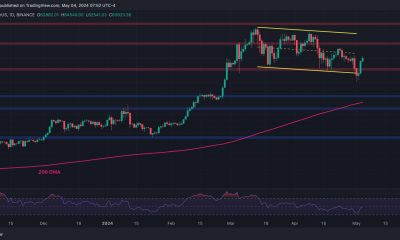Commodities
Oil prices rise as Middle East disruptions persist; US payrolls awaited


© Reuters.
Investing.com– Oil prices rose in Asian trade on Friday as focus remained on supply disruptions in the Middle East, although gains were somewhat limited in anticipation of key U.S. payrolls data.
The ongoing conflict in the Red Sea saw some escalation this week as U.S.-led forces clashed with the Iran-aligned, Yemeni Houthi group. The Israel-Hamas also war raged on, now appearing to have spilled over into Lebanon.
On the oil supply front, Syria halted production at its biggest oilfield due to protests in the region, taking about 300,000 barrels per day of supply offline.
While concerns over some disruptions to Middle East supplies drove a recovery in crude this week, the rebound was cut short by data showing a massive build in U.S. oil product inventories in the final week of 2023. The reading indicated that demand remained weak in the world’s largest fuel consumer, while local markets were also well-supplied.
expiring March rose 0.6% to $78.02 a barrel, while rose 0.7% to $72.83 a barrel by 20:08 ET (01:08 GMT). Both contracts were set to end the week about 1% higher after logging bruising losses in 2023.
Dollar rebound weighs on oil ahead of payrolls data
A rebound in the also weighed on oil prices, as the greenback raced to over three-week highs on growing uncertainty over the Federal Reserve’s plans for interest rate cuts.
While the Fed signaled it will cut interest rates in 2024, it did not specify the timing or scale of the cuts. Traders were also seen slightly winding back expectations that the Fed will begin trimming rates by as soon as March 2024.
data for December, which is due later on Friday, is expected to offer more cues on the path of interest rates, given that labor market strength is a key consideration for the Fed when deciding on interest rates.
Lower interest rates are expected to eventually stimulate economic activity and potentially drive up oil demand later in 2024. But until then, demand is expected to weaken as major global economies come under more pressure from high lending rates.
US inventory data cuts short oil recovery
U.S. and inventories both grew more than 10 million barrels each in the week to December 29, official data showed on Thursday.
While fell by about 5 million barrels, analysts said the draw was likely due to the U.S. filling a supply deficit from disruptions in the Middle East.
The build in gasoline and distillates signaled that demand in the world’s largest fuel consumer remained languid, although the trend could also be attributed to weak travel trends during the winter season.
U.S. production also stayed close to record highs, while exports increased.
Commodities
Oil settles down on US jobs data, steepest weekly loss in 3 months

By Nicole Jao
NEW YORK (Reuters) -Oil prices settled lower on Friday, and posted their steepest weekly loss in three months as investors weighed weak U.S. jobs data and possible timing of a Federal Reserve interest rate cut.
futures for July settled 71 cents lower, or 0.85%, to $82.96 a barrel. U.S. West Texas Intermediate crude for June fell 84 cents, or 1.06%, to $78.11 a barrel.
Investors were concerned that higher-for-longer borrowing costs would curb economic growth in the U.S., the world’s leading oil consumer, after the Federal Reserve decided this week to hold interest rates steady.
For the week, Brent declined more than 7%, while WTI fell 6.8%.
U.S. job growth slowed more than expected in April and the annual wage gain cooled, data showed on Friday, prompting traders to raise bets that the U.S. central bank will deliver its first interest rate cut this year in September.
“The economy is slowing a little bit,” said Tim Snyder, economist at Matador Economics. “But (the data) gives a path forward for the Fed to have at least one rate cut this year,” he said.
The Fed held rates steady this week and flagged high inflation readings that could delay rate cuts. Higher rates typically weigh on the economy and can reduce oil demand.
The market is repricing the expected timing of possible rate cuts after the release of softer-than-expected monthly jobs data, said Giovanni Staunovo, an analyst at UBS.
U.S. energy companies this week cut the number of oil and rigs operating for a second week in a row, to the lowest since January 2022, Baker Hughes said in its closely followed report on Friday.
remove ads
.
The oil and gas rig count, an early indicator of future output, fell by eight to 605 in the week to May 3, in the biggest weekly decline since September 2023. The number of oil rigs fell seven to 499 this week, in the biggest weekly drop since November 2023. [RIG/U]
Geopolitical risk premiums due to the Israel-Hamas war have faded as the two sides consider a temporary ceasefire and hold talks with international mediators.
Further ahead, the next meeting of OPEC+ oil producers – members of the Organization of the Petroleum Exporting Countries and allies including Russia – is set for June 1.
Three sources from the OPEC+ group said it could extend its voluntary oil output cuts beyond June if oil demand does not increase.
Money managers cut their net long futures and options positions in the week to April 30, the U.S. Commodity Futures Trading Commission (CFTC) said.
Commodities
Oil prices fall as hefty weekly losses loom on bets on tighter supplies suffer hit

Investing.com– Oil prices fell Friday, to remain on course for steep losses this week even as the dollar weakened following a weaker-than-expected U.S. jobs report, while data pointing to rising U.S. supplies reined in bets for tighter markets.
At 14:10 ET (18:10 GMT), fell 0.6% to $84.20 a barrel, while gained 0.6% to $79.44 a barrel. Oil prices are trading close to their weakest levels in seven weeks, and were set to lose between 5% and 6% this week.
Weaker dollar fails to turn negative tide as crude set for hefty weekly losses
The dollar fell as rate-cut hopes were boosted by data showing tight U.S. labor market is cooling after job gains and wages fell in April.
“Our forecast remains for three 25bp cuts this year starting in July, but have highlighted the path to cut in July has gotten narrower following the reinflation in 1Q24 data,” Morgan Stanley said in a Friday note.
As oil is priced in dollar, a weaker dollar tends to boost demand for non-dollar investors. Despite the dollar weakness was of little comfort to oil prices as most of the damage occurred earlier this week following an unexpected build in U.S. and data showing increased U.S. production.
This was coupled with easing fears of supply disruptions in the Middle East, as Israel and Hamas continued negotiations over a potential ceasefire.
Baker Hughes rig count dips below 500
Oilfield services firm Baker Hughes Co (NYSE:BKR) reported its weekly U.S. rig count, a leading indicator of future production, rose fell 499 from 506, pointing to weaker drilling activity even as the demand-heavy U.S. summer driving season approach.
remove ads
.
But the fall in rigs just as domestic output is rising suggest that drillers are squeezing more out of existing wells.
OPEC+ could extend production cuts
Still, crude found some relief on Friday from a softer , as the greenback retreated in anticipation of the nonfarm payrolls data.
Also helping the tone was a report from Reuters that the Organization of Petroleum Exporting Countries and allies, a group known as OPEC+, could potentially maintain their current run of 2.2 million barrels per day of production cuts beyond the end-June deadline, especially if demand does not pick up.
But cartel members are yet to begin formal talks over the matter. Still, extended production cuts by the cartel could herald tighter markets later in 2024.
Adnoc, the UAE’s national oil company, has increased its production capacity by 200,000 barrels per day to 4.85 million b/d, leaving the producer with a spare capacity above 1.7m b/d, after producing a little over 3.1m b/d in April.
“This could see the UAE push for a higher baseline when OPEC+ discusses its output policy for the second half of 2024,” ING added.
(Peter Nurse, Ambar Warrick contributed to this article.)
Commodities
Oil prices set for steep weekly losses; payrolls could drive sentiment

Investing.com– Oil prices edged higher Friday, lifting from near seven-week lows, but were headed for steep losses this week as signs of robust U.S. stockpiles and production dashed hopes for tight crude markets in the coming months.
At 08:05 ET (12:05 GMT), rose 0.6% to $84.20 a barrel, while gained 0.6% to $79.44 a barrel.
Crude set for hefty losses this week
Despite these gains, both contracts were still trading close to their weakest levels in seven weeks, and were set to lose between 5% and 6% this week.
An unexpected build in U.S. and data showing increased U.S. production suggested that oil markets were not as tight as traders were initially hoping.
This was coupled with easing fears of supply disruptions in the Middle East, as Israel and Hamas continued negotiations over a potential ceasefire.
Concerns over slowing economic growth – which could eat into demand – also came into play this week, especially after the U.S. Federal Reserve warned that it will keep interest rates higher for longer.
Middling data from top crude importer China also factored into fears of sluggish demand. Business activity in the country was seen slowing in April after a strong start to the year.
Markets were also on edge ahead of the release of key U.S. data later in the day, which is likely to factor into the outlook for interest rates.
“The US jobs report which will be released later today, has the potential to be a key driver for oil prices in the immediate term,” analysts at ING said, in a note.
remove ads
.
OPEC+ could extend production cuts
Still, crude found some relief on Friday from a softer , as the greenback retreated in anticipation of the nonfarm payrolls data.
Also helping the tone was a report from Reuters that the Organization of Petroleum Exporting Countries and allies, a group known as OPEC+, could potentially maintain their current run of 2.2 million barrels per day of production cuts beyond the end-June deadline, especially if demand does not pick up.
But cartel members are yet to begin formal talks over the matter. Still, extended production cuts by the cartel could herald tighter markets later in 2024.
Adnoc, the UAE’s national oil company, has increased its production capacity by 200,000 barrels per day to 4.85 million b/d, leaving the producer with a spare capacity above 1.7m b/d, after producing a little over 3.1m b/d in April.
“This could see the UAE push for a higher baseline when OPEC+ discusses its output policy for the second half of 2024,” ING added.
(Ambar Warrick contributed to this article.)

 Forex2 years ago
Forex2 years agoForex Today: the dollar is gaining strength amid gloomy sentiment at the start of the Fed’s week

 Forex2 years ago
Forex2 years agoHow is the Australian dollar doing today?

 Forex1 year ago
Forex1 year agoUnbiased review of Pocket Option broker

 Forex2 years ago
Forex2 years agoDollar to pound sterling exchange rate today: Pound plummeted to its lowest since 1985

 Cryptocurrency2 years ago
Cryptocurrency2 years agoWhat happened in the crypto market – current events today

 World2 years ago
World2 years agoWhy are modern video games an art form?

 Stock Markets2 years ago
Stock Markets2 years agoMorgan Stanley: bear market rally to continue

 Economy2 years ago
Economy2 years agoCrude oil tankers double in price due to EU anti-Russian sanctions

































